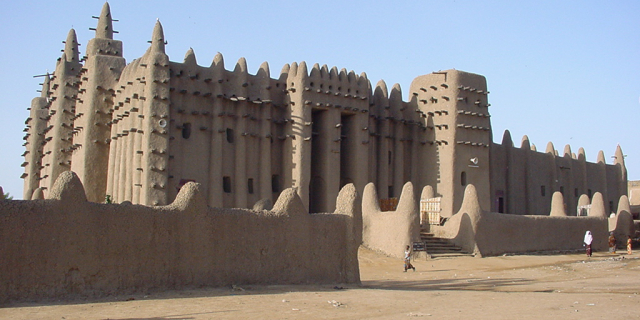The Djinguereber Mosque (Arabic: مسجد دجينجيربر; French: Mosquée de Djinguereber; from Koyra Chiini jiŋgar-ey beer 'grand mosque') in Timbuktu, Mali is a famous learning center of Mali. Built in 1327, and cited as Djingareyber or Djingarey Ber in various languages, its design is accredited to Abu Ishaq Al Sahili who was paid 200 kg (40,000 mithqals) of gold by Musa I of Mali, emperor of the Mali Empire. According to Ibn Khaldun, one of the best known sources for 14th century Mali, al-Sahili was given 12,000 mithkals of gold dust for his designing and building of the djinguereber in Timbuktu, but more recent analysis has disputed this.
Except for a small part of the northern facade, which was reinforced in the 1960s in alhore (limestone blocks, also widely used in the rest of the town), and the minaret, also built in limestone and rendered with mud, the Djingareyber Mosque i...Read more
The Djinguereber Mosque (Arabic: مسجد دجينجيربر; French: Mosquée de Djinguereber; from Koyra Chiini jiŋgar-ey beer 'grand mosque') in Timbuktu, Mali is a famous learning center of Mali. Built in 1327, and cited as Djingareyber or Djingarey Ber in various languages, its design is accredited to Abu Ishaq Al Sahili who was paid 200 kg (40,000 mithqals) of gold by Musa I of Mali, emperor of the Mali Empire. According to Ibn Khaldun, one of the best known sources for 14th century Mali, al-Sahili was given 12,000 mithkals of gold dust for his designing and building of the djinguereber in Timbuktu, but more recent analysis has disputed this.
Except for a small part of the northern facade, which was reinforced in the 1960s in alhore (limestone blocks, also widely used in the rest of the town), and the minaret, also built in limestone and rendered with mud, the Djingareyber Mosque is made entirely of earth plus organic materials such as fibre, straw and wood. It has three inner courts, two minarets and twenty-five rows of pillars aligned in an east-west direction and a prayer space for 2,000 people.
Djinguereber is one of three madrassas composing the University of Timbuktu. It was inscribed on the list of UNESCO World Heritage Sites in 1988, and in 1990, it was considered to be in danger due to sand encroachment. A four-year project towards the restoration and rehabilitation of the Mosque began in June 2006, and is being conducted and financed by the Aga Khan Trust for Culture.
On 26 February 2010, during Mawlid (a festival to mark the birth anniversary of Muhammad), a stampede at the mosque killed around 26 people and injured at least 55 others, mostly women and children.






























Add new comment